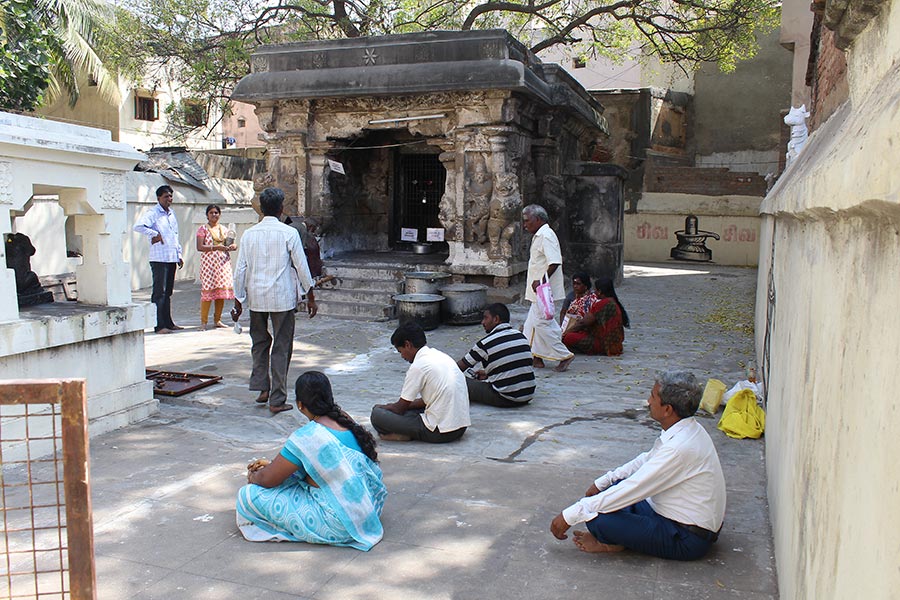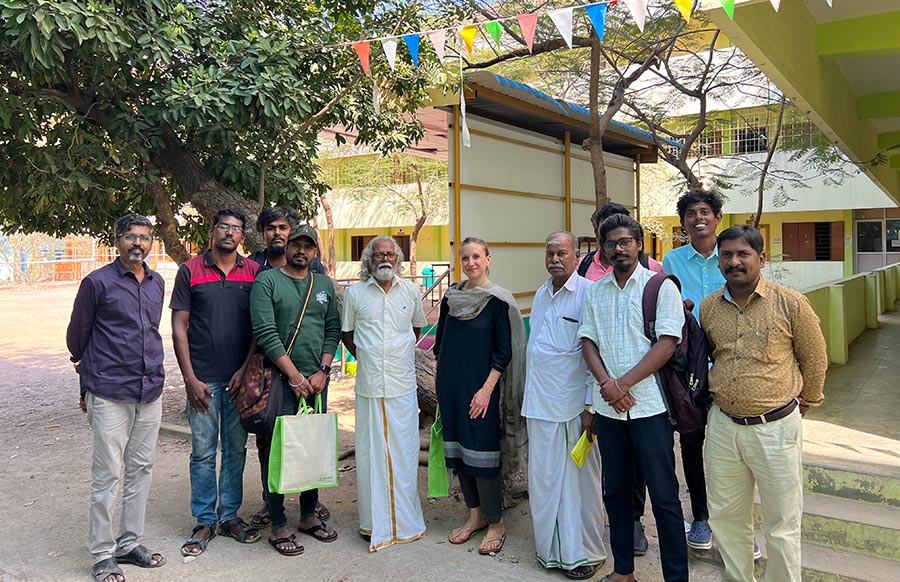Writing the City of Infinite Temples
The idea to publish my research on the city of Kanchipuram (Kanchi) with Amsterdam University Press as part of the IIAS Asian Cities series first arose at a bar in Shanghai during an Urban Knowledge Network Asia (UKNA) conference. At the time, I was working on a monograph about Kanchi that would trace the emergence of this South Indian city as a major royal capital and multireligious pilgrimage destination during the era of the Pallava and Chola dynasties (circa 7th -13th centuries). 1 It would present the first-ever comprehensive picture of historical Kanchi, locating the city and its more than 100 spectacular Hindu temples at the heart of commercial and artistic exchange that spanned India, Southeast Asia, and China [Fig. 1].
Research for the book began with my PhD, which I completed at Yale in 2017, in the field of the History of Art. I strongly felt that the purpose of publishing was to share that work with a broader audience with interests that extend well beyond the boundaries of traditional art history. I also sought the opportunity to contribute to a global dialogue about urbanism, infrastructure, water, land, and community. What better venue than IIAS?
I am immensely grateful to the people who made the publication journey both efficient and enjoyable. 2 I am also appreciative of the anonymous peer reviewers, informal editors, and friends whose complex comments and hard questions only benefited the book. However, my deepest gratitude goes to the city of Kanchi itself, and to the people who so generously opened their doors and shared their local knowledge with me.
Layers of time
Constructing Kanchi: City of Infinite Temples creates a layered vision of Kanchi, from its establishment as a royal capital, to its present-day preservation of cultural heritage. This preservation ranges from archaeological monuments to a cycle of rituals and festivals that keep the city pulsing with life. In the first two chapters, I map Kanchi geographically, tracing the city’s shifting contours and the emergence of a major pilgrimage route that led precisely through its urban core. The third chapter transitions outwards beyond Kanchi proper, to look at patterns of movement that linked the city to its hinterland. It also considers connections with multireligious urban capitals across a wider South Asian and Southeast Asian region. In the fourth chapter, I investigate colonial encounters with Kanchi and the shaping of the city’s identity as a Hindu temple town.
Future of heritage
As a researcher, it is important to me that my work benefits the communities I study through the exchange of knowledge and sustained engagement with my research sites. I completed my long-term, Tamil Nadu-based fieldwork in 2016, and when I returned to Kanchi a few years later having completed my PhD, the local leaders and community activists organized a lecture (with Tamil translation), so that I could share my research with an audience that ranged from Masters students to respected elders within the society. I encouraged the students to take my findings and carry them forwards—work on manuscripts in languages I cannot read, interview the city’s thriving silk weavers and study their genealogies, continue locating sculptures and architectural fragments in local temples (because even as I try to map all of them, more inevitably turn up), and pursue topics that lay beyond the scope of my project.
I returned to Kanchi again in February 2023 (for the first time since the onset of the global pandemic), and again I was invited to lecture, this time at Sri Sankara College of Arts and Sciences, Kanchi’s foremost university. This time, however, the request was more specific. Rather than sharing my findings, the community asked me to speak about the future of Kanchi’s heritage.
In recent years, I have become increasingly interested in this question—in part through the two Urban Knowledge Network Asia (UKNA) conferences I have been part of, and by reading about other IIAS initiatives. How can I responsibly work with cultural heritage that, on the one hand, lacks the archaeological protection it needs in order to preserve its historical form, and that, on the other hand, continues to serve the shifting needs of its local populations in other ways?
During the decade I have been working in Kanchi, I have observed on multiple occasions the power of local efforts to revitalize cultural heritage sites that are in a state of distress. A remarkable example took place throughout the pandemic, at the temple of Airāvateśvara, an elegant, royally commissioned monument that dates to the eighth century and stands at the center of town. When I arrived in Kanchi for fieldwork in 2013, simply finding Airāvateśvara proved itself a challenge. The temple was hidden behind a compound wall with a perpetually locked gate set back from the main road. Its superstructure had fallen down long ago, meaning it was impossible to see from the street. I was finally able to access the temple after many attempts and only through the kind assistance of a tea seller, whose shop stood directly adjacent to the site. I photo-documented the dilapidated structure, its friable sandstone walls badly damaged by nature and a century of informal repairs [Fig. 2].

Fig. 2: Airāvateśvara Temple, Kanchi. (Photo by the author, 2015)
A month or so later, I arrived one morning to find the gate unlocked and cleaning underway. A generous donor had decided to sponsor a renovation and hired my friend the tea seller to oversee it. I was fortunate enough to be consulted about what should and should not be done to the temple itself. We agreed that, in the absence of conservation expertise, dusting and light cleaning would be sufficient. Over the next few weeks, the beautiful sculptures steadily began to emerge from behind the cobwebs and overgrowth, and, similarly, people began to return to the temple.
During the pandemic, the Airāvateśvara temple came into even greater prominence as a place for daily food distribution, a Tamil practice called annadhanam. This effort, which began in August 2021, is driven by that same tea seller, who cooks the food in giant pots at the back of his shop and wraps it neatly in banana leaf packets for the people who line up in front of the temple. Since 2013, what was an abandoned lot has again become an important sacred space and place of peaceful gathering.
I shared the Airāvateśvara’s and other stories in my February 2023 lecture in Kanchi. Some people who attended will put their efforts in similar directions, and many have expressed their intention to do so. I am invited to speak at Sri Sankara College anytime I visit Kanchi. Having the community request the topic challenges me to ask new questions, observe my surroundings differently, rethink my findings in unexpected ways, and make new connections [Fig. 3].

Fig. 3: Sri Sankara College of Arts & Sciences, Kanchi. (Photo courtesy of a Sri Sankara College staff member, 2023)
Research continues
Since completing my monograph, I have published several articles that expand the purview of my study to look more in depth at connections between monuments and landscapes across South Asia and Southeast Asia. An article in River Cities in Asia: Waterways in Urban Development and History—another recent IIAS publication—argues that the drying and deterioration of rivers in and around Kanchi has contributed to the disappearance of settlements that once were prosperous, productive centers. 3 Another article, which is available open access, concerns the physical and cultural landscape around the Tirukkālīśvara temple, a site I did not have space to discuss in Constructing Kanchi. 4 The research for that article led me to more systematically consider the communities that use the temples, and the ways in which they endure or transform over time.
Although I am a curator at the Smithsonian’s National Museum of Art, I do not plan to create an exhibition about Kanchi (a question I get asked not infrequently). I would not be able to responsibly or satisfyingly bring the experience of Kanchi into the galleries because it is so intrinsically bound with place. However, my fieldwork in Tamil Nadu—especially the ways in which I walked through Kanchi mapping and memorizing its landscape—informs my curatorial practice and draws me to topics and modes of display that engage the senses and inspire movement. My fieldwork is physically oriented, and I believe that visiting a museum is also a physical experience. I recently curated an exhibition titled Revealing Krishna: Journey to Cambodia’s Sacred Mountain, which connected a Cambodian sculpture of the Hindu god Krishna lifting a sacred mountain with the actual sacred mountain where the sculpture was originally installed. 5 The exhibition included a range of digital experiences that required viewers to immerse themselves fully in the tropical landscape through sweeping cinematographic and photographic installations. In my future projects, I plan to build on this type of exhibition and continue to explore connections between art, architecture, and landscapes.
Kanchi is a place to which I will always return—it is the city that keeps on giving, a place that keeps revealing its multilayered history, and keeps transforming before our eyes. I hope that those who read Constructing Kanchi: City of Infinite Temples will be awed, as I am, by Kanchi’s ability to continuously thrive.
Emma Natalya Stein is Assistant Curator of South Asian and Southeast Asian Art at the National Museum of Asian Art, Smithsonian, in Washington, D.C. E-mail: SteinE@si.edu
Print Journeys
For IIAS Publications, we invite authors and editors who have recently published in the IIAS Publications Series to talk about their writing experiences. What inspired them to conduct research? What did they encounter in the field? What are the stories behind their books? For more information on IIAS books, please visit www.iias.asia/books